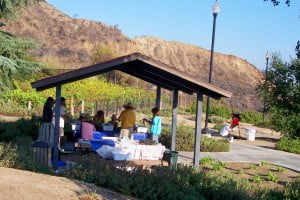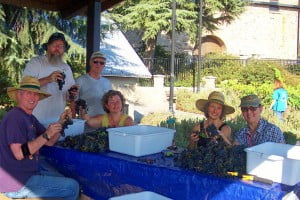
By Shana LiVIGNI
Deukmejian Wilderness Park is a 709-acre site that is primarily undisturbed and usually covered with chaparral and sage scrub. The elevation ranges from 2,159 feet at the Markridge Road entrance to 4,775 feet at its peak. In 1898, French immigrant and successful wine maker George Le Mesnager bought the property and between 1914 and 1918 constructed the stone barn (still standing today) and other buildings. In 1920, prohibition ended wine making for 13 years, but in 1933 he resumed his craft.
In December of that year, a massive fire swept through the area and wiped out the vineyard, equipment and most of the smaller buildings. Flooding followed the fire and eventually the barn was rebuilt. The Le Mesnager family moved to the site and lived there until 1960. A developer bought the property in 1968 with plans to build homes, but the City of Glendale stepped in and purchased it in 1988, renaming it Deukmejian Wilderness Park.
A few years ago, The Historical Society of Crescenta Valley began replanting the vineyard. Vice President Stuart Byles credits the city of Glendale with securing the society’s involvement in restoring the vineyards.
“John Pearson is the [city’s] project manager of the whole Wilderness Park remodeling project and he had a vision for this, to get locals involved, to get all of this going. He’s been the biggest supporter and force in the project,” he said.
The first vintage was bottled last year and yielded about 35 gallons, but this year, because of the damage by birds and wasps, five of the seven rows of grapes produced only one gallon of wine. Last Sunday, HSCV members picked and sorted the remaining two rows of grapes, hoping the quality will be as good as last year’s crop. Heather D’Augustine – affectionately nicknamed “the wine mistress” – owns a vineyard in Echo Park and offered her expertise in calculating when to harvest grapes and what soil is needed for each type of grape. Heather is considered a primary reason why the Deukmejian vineyard has been successful.
HSCV President Mike Lawler said the Stonebarn Vineyard Conservancy, the name under which the wine is produced, is sponsored by the HSCV organization, and is one of the reasons that the society is involved with the grape harvest.

“We have three sets of grapes,” he explained. “The first two rows are Alicante-Boucher, named after the city in Spain. The next two rows are Red Flame, which essentially is a table grape, and the last three rows are Early Burgundy. We are harvesting the two rows of Alicante grapes that survived the birds and bugs.”
Fires destroyed the area in 1933, and the Station Fire burned right up to the site’s perimeter. Fire fighters were instructed to protect the historic barn and surrounding area “at all costs.” Controlled backfires were set and the 12 acres that contain The Stonebarn Vineyard Conservancy, amphitheater, picnic area and meadow were saved.
But it’s not only for the wine that the pickers are grateful. According to Mike Lawler, the reasons run deeper. “The whole purpose is a celebration of this historic vineyard on this historic grape growing property.”
